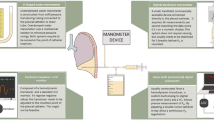Abstract
About 1.5 million people are diagnosed with pleural effusion each year in the USA with approximately 180,000 thoracenteses performed each year. The measurement of pleural pressure during therapeutic thoracentesis has been proposed as a useful benchmark to guide therapeutic thoracentesis. The proposed benefits of pleural manometry include diagnosis of unexpandable lung, prevention of re-expansion pulmonary edema (REPE), and pneumothorax ex vacuo, as well as prediction of successful pleurodesis in malignant effusions. Although pleural manometry undeniably offers insights into pleural space physiology, the paucity of data on improved clinical outcomes and the absence of standardized methodology and teaching opportunities have hampered its widespread adoption by pulmonologists.


Similar content being viewed by others
References
Papers of particular interest, published recently, have been highlighted as: • Of importance
Light RW. Pleural diseases. 6th ed. Philadelphia: Lippincott Williams & Wilkins; 2013.
Otis AB. History of respiratory mechanics. In: Fishman AP, Macklem PT, Mead J, Geiger SR, editors. Handbook of respiratory physiology: a critical, comprehensive presentation of physiological knowledge and concepts. Bethesda: American Physiologic Society; 1986. p. 1–12.
Farber JE, Lincoln NS. The unexpandable lung. Am Rev Tuberc. 1939;40:704–9.
Akulian J, Yarmus L, Feller-Kopman D. The evaluation and clinical application of pleural physiology. Clin Chest Med. 2013;34(1):11–9.
Estenne M, Yernault JC, De Troyer A. Mechanism of relief of dyspnea after thoracocentesis in patients with large pleural effusions. Am J Med. 1983;74:813–9.
Wang JS, Tseng CH. Changes in pulmonary mechanics and gas exchange after thoracentesis on patients with inversion of a hemidiaphragm secondary to large pleural effusion. Chest. 1995;107:1610–4.
Light RW, Jenkinson SG, Minh VD, et al. Observations on pleural fluid pressures as fluid is withdrawn during thoracentesis. Am Rev Respir Dis. 1980;121(5):799–804.
Doelken P, Huggins JT, Pastis NJ, et al. Pleural manometry: technique and clinical implications. Chest. 2004;126(6):1764–9.
Boshuizen RC, Sinaasappel M, Vincent AD, et al. Pleural pressure swing and lung expansion after malignant pleural effusion drainage: the benefits of high-temporal resolution pleural manometry. J Bronchol Interv Pulmonol. 2013;20:200–5.
Lee HJ, Yarmus L, Kidd D, Ortiz R, Akulian J, Gilbert C, et al. Comparison of pleural pressure measuring instruments. Chest. 2014;146(4):1007–12.
Salamonsen M, Ware R, Fielding D. A new method for performing continuous manometry during pleural effusion drainage. Respiration. 2014;88(1):61–6.
Doelken P, Sahn SA. Trapped lung. Sem Respir Crit Care Med. 2001;22:631–5.
Feller-Kopman D, Walkey A, Berkowitz D, Ernst A. The relationship of pleural pressure to symptom development during therapeutic thoracentesis. Chest. 2006;129(6):1556–60. This paper showed correlation between pleural pressure and patient’s symptoms during therapeutic thoracentesis.
Feller-Kopman D. Therapeutic thoracentesis: the role of ultrasound and pleural manometry. Curr Opin Pulm Med. 2007;13:312–8.
Heidecker J, Huggins JT, Sahn SA, Doelken P. Pathophysiology of pneumothorax following ultrasound-guided thoracentesis. Chest. 2006;130(4):1173–84. This study provides discussion about pleural elastance, its relationship to unexpandable lung, and the development of unintentional pneumothorax.
Villena V, López-Encuentra A, Pozo F, De-Pablo A, Martín EP. Measurement of pleural pressure during therapeutic thoracentesis. Am J Respir Crit Care Med. 2000;162(4 pt 1):1534–8.
Huggins JT, Sahn SA, Heidecker J, Ravenel JG, Doelken P. Characteristics of trapped lung: pleural fluid analysis, manometry, and air-contrasted CT. Chest. 2007;131:206–13. This article discusses the use of a diagnostic pneumothorax to clarify the features of unexpandable lung.
Huggins JT, Doelken P, Sahn SA. The unexpandable lung. F1000 Med Rep. 2010;2:77.
Pavlin J, Cheney Jr FW. Unilateral pulmonary edema in rabbits after reexpansion of collapsed lung. J Appl Physiol. 1979;46(1):31–5.
Miller WC, Toon R, Palat H, et al. Experimental pulmonary edema following re-expansion of pneumothorax. Am Rev Respir Dis. 1973;108(3):654–6.
Huggins JT, Doelken P. Pleural manometry. Clin Chest Med. 2006;27(2):229–40.
Sivrikoz MC, Tuncozgur B, Cekmen M, et al. The role of tissue reperfusion in the reexpansion injury of the lungs. Euro J Cardiothorac Surg. 2002;22:721–7.
Her C, Mandy S. Acute respiratory distress syndrome of the contralateral lung after reexpansion pulmonary edema of a collapsed lung. J Clin Anesth. 2004;16:244–50.
Feller-Kopman D, Berkowitz D, Boiselle P, Ernst A. Large volume thoracentesis and the risk of reexpansion pulmonary edema. Ann Thorac Surg. 2007;84(5):1656–61. This study showed that REPE is rare and independent of fluid removed, pleural pressure or elastance.
Jones PW, Moyers JP, Rogers JT, Rodriguez RM, Lee YC, Light RW. Ultrasound-guided thoracentesis: is it a safer method? Chest. 2003;123(2):418–23.
Pannu J, DePew ZS, Mullon JJ, Daniels CE, Hagen CE, Maldonado F. Impact of pleural manometry on the development of chest discomfort during thoracentesis: a symptom-based study. J Bronchol Interv Pulmonol. 2014;21(4):306–13.
Lan RS, Lo SK, Chuang ML, Yang CT, Tsao TC, Lee CH. Elastance of the pleural space: a predictor for the outcome of pleurodesis in patients with malignant pleural effusion. Ann Intern Med. 1997;126:768–74.
Author information
Authors and Affiliations
Corresponding author
Ethics declarations
Conflict of interest
Fayez Kheir and Fabien Maldonado each declare no potential conflicts of interest.
Human and animal rights and informed consent
This article does not contain any studies with human or animal subjects performed by any of the authors.
Additional information
This article is part of the Topical Collection on Pleural Diseases and Mesothelioma
Rights and permissions
About this article
Cite this article
Kheir, F., Maldonado, F. Manometry in pleural drainage: essential practice or over-rated gadget?. Curr Pulmonol Rep 5, 7–12 (2016). https://doi.org/10.1007/s13665-016-0131-2
Published:
Issue Date:
DOI: https://doi.org/10.1007/s13665-016-0131-2




